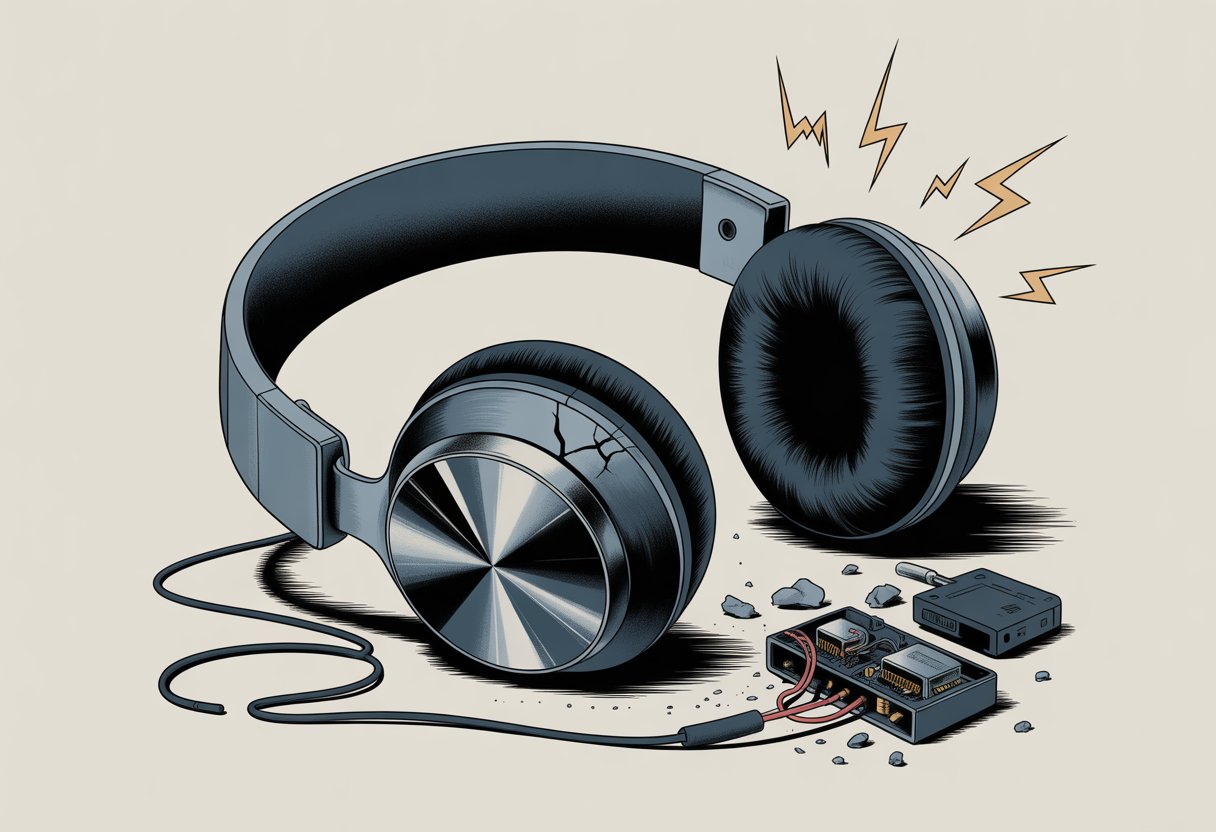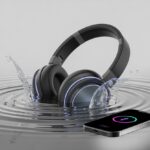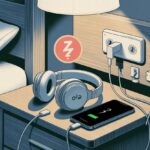We’ve all felt that split-second panic when Bluetooth headphones slip out of our hands and smack the floor. Picking them up and realizing they’ve stopped working? That’s a whole new level of frustration.
Usually, when Bluetooth headphones stop working after a fall, something inside gets knocked loose or damaged.

Maybe the tiny speaker inside takes the hit, or the battery, or the little connection points that keep things running. Even if they look fine on the outside, a hard drop can scramble the inside in invisible ways.
Sometimes, a reset or company support comes to the rescue. Other times, we just have to replace them.
Let’s poke around at what actually happens when our favorite earbuds hit the ground, why a simple drop can ruin them, and what we can realistically do about it.
Immediate Effects of Dropping Bluetooth Headphones
When we drop Bluetooth headphones, we get a weird mix of hope, dread, and maybe a new appreciation for gravity. Cracks, weird malfunctions, or total silence can all show up at once, thanks to the delicate electronics, tiny wires, and, honestly, our luck.
Here’s what tends to go wrong when our earbuds take a nosedive.
Physical Damage and Functionality
A fall can do way more than just scratch the surface. Inside, small wires and solder points might snap or loosen—even from a minor drop.
If you hear something rattling when you shake them, it’s usually a bad sign.
Sometimes only one side works after a drop. Buttons or touch controls might freeze up, or the whole headset just goes silent.
Cracked housings open the door for dust or moisture, which can make things worse over time.
When things get really dicey, the speakers inside stop playing sound—leaving us with nothing but silent ear jewelry. Reddit users have called dropped headphones “expensive paperweights,” and honestly, it’s hard to argue with that.
Bluetooth Connection Issues
Bluetooth does not appreciate rough treatment. After a drop, the internal antenna can shift or break, making it hard for the headset to stay connected.
One minute we’re jamming out, and the next, the audio cuts out or vanishes entirely.
Bluetooth already deals with distance and interference from other devices. Add in some physical trauma, and we might see more connection drops than usual.
Our headphones might refuse to pair, show up as “unknown device,” or connect for a second and then disappear. Sometimes a reset helps, but often, the trouble comes from hidden breaks inside that we can’t spot.
Charging Case and Power Problems
Let’s not overlook the charging case. If we drop everything together, the case itself can crack or the charging pins might bend.
That means our headphones might not charge—or only charge if we hold the lid in a weird position.
Battery connectors inside the headphones can take a hit too. Suddenly, the battery drains fast or won’t charge at all.
This leaves us with headphones that seem fine until we try to turn them on and get nothing but silence.
Dropping can also knock sensors or magnets out of place, so the headphones don’t know when to turn on or off.
Charging lights might act strange—or not light up at all, no matter how much we beg. There’s nothing quite like a charging case that’s just a sad little box.
Troubleshooting Bluetooth Functionality
Let’s be real, sometimes our Bluetooth headphones just need a gentle nudge (not a shove off the table) to get going again. If they’ve taken a tumble and now act stubborn, we’ve still got a few things to try before giving up.
Reconnecting the Bluetooth Device
Before we start shopping for replacements, let’s try reconnecting the Bluetooth device.
Make sure the headphones are charged (it’s wild how often we forget this and panic for no reason).
Turning the headphones off and back on is a classic move that surprisingly works more often than we’d like to admit.
Check that the device’s Bluetooth is switched on. Once both are powered up, look for the headphones in the pairing list and try connecting again.
If they don’t show up, maybe the hardware is damaged—or maybe they’re just being difficult.
Keep the headphones and device close together (awkwardly close is fine). Bluetooth works best within a short range, so don’t wander off and wonder why your music cuts out.
Walls, fridges, or even a pet iguana can mess with the signal—Sony has a whole page about this.
Resetting Bluetooth Functionality
If reconnecting does nothing, it’s time for a reset. Most devices have a reset button or key combo—check the manual or, let’s be honest, Google it.
Some headphones need us to hold the power button for a few seconds until a light blinks or we hear a sound.
On our phone or computer, “forget” the headphones in the Bluetooth list, then add them back like nothing happened.
Windows users can use the Bluetooth troubleshooter—find it under Settings > Update & Security > Troubleshoot > Bluetooth (thanks, Microsoft Support).
If the headphones still don’t work, the fall probably caused hardware damage. At that point, we’ve tried everything short of interpretive dance.
Resolving Software and Hardware Problems
Sometimes, Bluetooth headphones just give up after a drop, but it’s not always the end of the road. The problem could be with the hardware inside or the software on our devices.
Device Manager Checks on Your Phone or PC
When headphones suddenly stop working, it’s tempting to blame gravity. But before we mourn, let’s check the device manager on the phone or PC.
On Windows, open Device Manager, look for Bluetooth, and see if any yellow triangle warnings pop up.
If we spot one, update or reinstall the drivers—it might only take a quick refresh to get things working.
If the headphones don’t show up at all, maybe the device isn’t detecting them, which could mean hardware trouble or a software hiccup.
On phones, visit the Bluetooth settings, unpair the headphones, and try pairing again.
Sometimes, just restarting the device works wonders, as plenty of guides suggest.
Basically, it’s the classic “turn it off and on again” move, but with more menus.
Factory Resetting Your Headphones
If poking around in settings doesn’t help, it’s time for a factory reset. This wipes out any bad settings that might have kicked in after a drop.
Each brand does this a bit differently. Usually, we hold down specific buttons for a few seconds—often the power button and volume down, but check the manual so we don’t accidentally trigger something weird.
After resetting, the headphones forget all devices, so we’ll need to pair them again from scratch.
It’s a little annoying, but it can fix strange software bugs that pop up after a drop.
If a reset doesn’t help and the headphones still won’t work, something inside probably broke. That’s the universe’s way of reminding us not to drop our gadgets.
Extra Tips to Restore Wireless Harmony
Sometimes, Bluetooth headphones just won’t cooperate, especially after a tumble. Before we threaten to toss them out the window, let’s try a few more tricks to get them working—and know when it’s time to call for help.
Testing Headphones With Different Devices
Let’s play musical chairs with our gadgets. Plug the headphones into a different phone, tablet, or computer to see if the issue is the headphones or just a cranky device.
Here’s a quick way to check:
- Reconnect: Put the headphones in pairing mode and try connecting to something else.
- See What Happens: If music plays from one device but not the other, the headphones are probably fine.
- Check for Updates: Sometimes, all they want is a software update.
Some brands have a reset function—check the website for a button combo that might bring things back to life.
If the headphones still don’t work on any device, we might have a bigger problem. There’s a helpful discussion about dropped earbuds with more steps to try.
When to Seek Professional Repair
If we’ve tried everything short of summoning a tech wizard, maybe it’s time to let the experts handle it.
Most headphones come with a warranty, especially if we bought them recently. It’s worth checking.
Here’s what to think about:
- Warranty Status: If it’s covered, let’s make the company fix it—or at least try.
- Cost of Repair: Sometimes repairs cost as much as a new pair.
- DIY Dangers: Opening them up with a butter knife probably won’t help and could void the warranty.
Some brands just replace broken headphones instead of repairing them. If needed, a call to customer support can be our best move. There’s more info in forums like this one.
If nothing works, hey, at least we tried. We can always keep one good earbud for backup karaoke nights.
Prevention and Care to Avoid Future Drops
Bluetooth headphones don’t like surprise meetings with the floor. By keeping them safe when we’re not using them and making sure their software stays updated, we can avoid new disasters and keep them working longer.
Safe Storage and Handling Solutions
We’ve all been there—one moment the headphones are in your hands, and suddenly they’re flying through the air like little gymnasts. Honestly, the best move is to use the case that came with your headphones.
It’s not just for show; it really does help prevent scratches and those annoying accidental drops.
When you’re not using your headphones, give them a safe spot—a pouch, a drawer, or just pop them back in their case. Tossing them into a bag with keys and coins? That’s just asking for trouble (and probably a cracked earbud).
If you’re always on the move, try clipping them with a carabiner or using a neck strap. It’ll save you from digging through couch cushions or the bottom of your backpack later.
Try unplugging and handling your headphones with both hands, especially if your fingers are slippery (or, let’s be honest, covered in snack dust). If you’re the forgetful type, make a habit of putting your headphones in the same place every time.
That way, you’ll avoid those frantic searches and lower the odds of dropping them somewhere weird.
Keeping Firmware and Software Up to Date
Headphones these days are smarter than they look, and their software does a lot of the heavy lifting. Keeping everything updated matters just as much as charging them.
Updates fix bugs, boost connectivity, and sometimes add new features to help spot issues like disconnects or odd behavior after a drop.
Manufacturers usually post updates on their websites or in their apps. If your headphones start acting up, or just as a regular habit, check for firmware updates.
Sometimes a quick update resets things that got messed up after a fall.
Set a reminder on your phone to check for updates every couple of months. It’s way easier than trying to troubleshoot a glitchy connection after your headphones take a tumble.
If you need a special app for updates, it’s worth the download just to keep everything running smoothly.
Cookies and Connections: Do They Really Matter?
Let’s be real—when someone says “cookies,” most of us picture snacks, not Bluetooth drama.
Unfortunately, the cookies on our devices are just boring little data files, not something you’d dunk in milk.
So, do they have anything to do with headphones glitching out after you drop them? Honestly, nope.
Cookies just track which sites you visit or help you stay logged in.
They don’t mess with Bluetooth connections.
You can clear cookies or accept every cookie policy you see, but your headphones won’t notice.
Connections, though, are a whole different animal.
If you drop your headphones, you might actually mess up the Bluetooth hardware or the settings.
That can make connecting a pain, no matter how many cookies you collect.
Quick checklist for connections:
- Is Bluetooth turned on?
- Are your headphones in pairing mode?
- Is your device close by—not hiding out in another room?
| What Matters | What Doesn’t Matter |
|---|---|
| Bluetooth Settings | Cookies |
| Physical Damage | Website Logins |
| Device Compatibility | Online Shopping Carts |
Cookies follow you around the web, but they won’t fix a busted headset.
Wouldn’t it be great if they could? For now, though, let’s just keep our eyes on the connections—not the cookie crumbs.
- Why is my fitness tracker not pairing with Apple Health? Troubleshooting for Technologically Cursed Mortals - December 22, 2025
- Why is my fitness tracker not updating firmware? Tech Tantrums and Update Woes Explained - December 21, 2025
- Why is the Sound Quality on My Bluetooth Headphones Poor? It’s Not Just Bad Music Taste! - December 21, 2025






